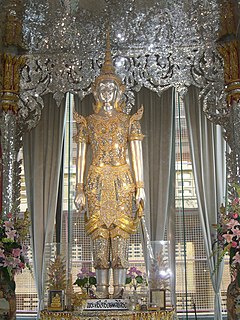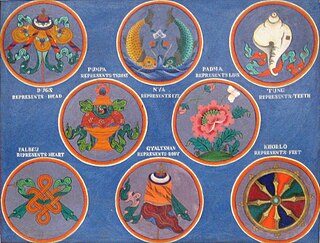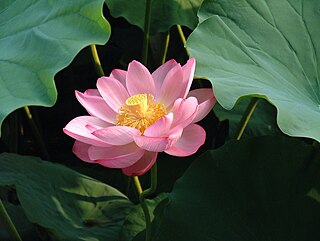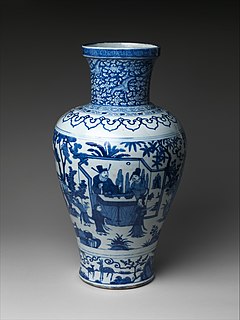
Guanyin, Guan Yin or Kuan Yin is the Buddhist bodhisattva associated with compassion. She is the East Asian equivalent of Avalokiteśvara, and has been adopted by other Eastern religions including Chinese folk religion. She was first given the appellation of "goddess of mercy" or the "mercy goddess" by Jesuit missionaries in China. The Chinese name Guanyin is short for Guanshiyin, which means "[The One Who] Perceives the Sounds of the World." On the 19th day of the sixth lunar month, Guan Shi Yin's attainment of Buddhahood is celebrated.

In Greek mythology, the lotus-eaters were a race of people living on an island dominated by the lotus tree, a plant whose botanical identity is uncertain. The lotus fruits and flowers were the primary food of the island and were a narcotic, causing the inhabitants to sleep in peaceful apathy. After they ate the lotus they would forget their home and loved ones, and only long to stay with their fellow lotus-eaters. Those who ate the plant never cared to report, nor return.

Maitreya or Metteyya, also known as Lord Maitreya Buddha, is regarded as the future Buddha of this world in Buddhist eschatology. As the 5th and final Buddha of our times, his goal would be to reinstate the Dharma, and as such, Maitreya is likely to be born in India. He is the direct successor of the current Buddha, Gautama. In some Buddhist literature, such as the Amitabha Sutra and the Lotus Sutra, the being is referred to as Ajita. Despite many individuals and holy men claiming to be Maitreya throughout history, all Buddhists firmly agree that he is yet to appear.

Nymphaea is a genus of hardy and tender aquatic plants in the family Nymphaeaceae. The genus has a cosmopolitan distribution. Many species are cultivated as ornamental plants, and many cultivars have been bred. Some taxa occur as introduced species where they are not native, and some are weeds. Plants of the genus are known commonly as water lilies, or waterlilies in the United Kingdom. The genus name is from the Greek νυμφαία, nymphaia and the Latin nymphaea, which mean "water lily" and were inspired by the nymphs of Greek and Latin mythology.

The Ashtamangala is a sacred suite of Eight Auspicious Signs endemic to a number of religions such as Hinduism, Jainism, and Buddhism. The symbols or "symbolic attributes" are yidam and teaching tools. Not only do these attributes point to qualities of enlightened mindstream, but they are the investiture that ornaments these enlightened "qualities". Many cultural enumerations and variations of the Ashtamangala are extant.

Nymphaea lotus, the white Egyptian lotus, tiger lotus, white lotus or Egyptian white water-lily, is a flowering plant of the family Nymphaeaceae.
Sacred lotus may refer to:

A kinnara is a celestial musician, part human and part bird, who are musically paradigmatic lovers, in Hinduism and Buddhism. In these traditions, the kinnaras (male) and kinnaris are two of the most beloved mythological characters. Believed to come from the Himalayas, they often watch over the wellbeing of humans in times of trouble or danger. An ancient Indian string instrument is known as the Kinnari vina. Their character is also clarified in the Adi Parva of the Mahabharata, where they say:
We are everlasting lover and beloved. We never separate. We are eternally husband and wife; never do we become mother and father. No offspring is seen in our lap. We are lover and beloved ever-embracing. In between us we do not permit any third creature demanding affection. Our life is a life of perpetual pleasures.
In a number of countries, plants have been chosen as symbols to represent specific geographic areas. Some countries have a country-wide floral emblem; others in addition have symbols representing subdivisions. Different processes have been used to adopt these symbols – some are conferred by government bodies, whereas others are the result of informal public polls. The term floral emblem, which refers to flowers specifically, is primarily used in Australia and Canada. In the United States, the term state flower is more often used.

The lotus, Nelumbo nucifera, is an aquatic plant that plays a central role in the art of Indian religions such as Hinduism, Buddhism, Jainism and Sikhism.
White lotus can refer to:

For the poem by Heine, set to music as a lied by Schumann, see Die Lotosblume
Apple Blossom may refer to:

Nymphaea nouchali, often known by its synonym Nymphaea stellata, or by common names blue lotus, star lotus, red water lily, dwarf aquarium lily, blue water lily, blue star water lily or manel flower, is a water lily of genus Nymphaea. It is native to southern and eastern parts of Asia, and is the national flower of Bangladesh and Sri Lanka. In Sanskrit, it is utpala. This species is usually considered to include the blue Egyptian lotus N. nouchali var. caerulea. In the past, taxonomic confusion has occurred, with the name Nymphaea nouchali incorrectly applied to Nymphaea pubescens.
Pankaj is a Hindu given name, common in India and Nepal. It has its roots in the Sanskrit word paṅkaja which refers to the lotus flower. The word is a compound of paṅka 'mud' and the suffix -ja 'born from, growing in'. The associated symbolism is of the lotus that is born in mud and blossoms after arising from mud. The lotus flower is also the national flower of India and is considered to be a symbol of Buddhist teaching.

The Vase with the Poet Zhou Dunyi is a traditional Chinese porcelain vase produced in 1587, during the Ming Dynasty. The Vase can be identified by its Wanli Mark and period qualities, constituting its cobalt blue paintings decorating the transparent glazed porcelain. The Vase is now in the Metropolitan Museum of Art in New York City, purchased via the credit line of the Rogers Fund within the Museum. The structure and shape of the vase in accompaniment to the complex iconography is notable as it is meant to encouraging the viewer to read and understanding the image presented and their value in Chinese literati culture.

Utpala in Sanskrit is a neuter noun with two meanings, both given by Amarakoṣa. The first meaning is Nymphaea caerulea, the "blue lotus", also known as kuvalaya in Sanskrit. The second meaning of utpala is a variety of medicinal plant known as 'kooṭh' in Hindi and 'kusṭham, vyādhi, paribhavyam or pāribhavyam, vāpyam, pākalam' according to Amarkośa.
Lotus blossom refers to the pink or white flower of lotus plant Nelumbo nucifera. It may also refer to:











